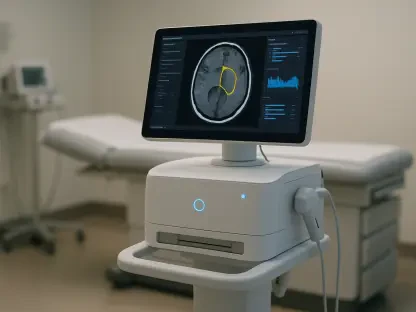Radiopharmaceuticals, a specialized class of radioactive compounds, are poised to transform healthcare through their significant roles in diagnostic imaging and therapeutic applications. As these powerful agents gain prominence in nuclear medicine, their market potential is projected to swell from USD 6.8 billion in 2024 to USD 19.15 billion by 2035, experiencing a robust compound annual growth rate (CAGR) of 9.95% between the years 2025 and 2035. This growth is fueled by factors such as rising chronic disease incidences, technological innovations, and a shift towards personalized medicine. Herein, we dissect the trends, challenges, and opportunities within this dynamic market, shedding light on the evolving landscape and its implications for future healthcare delivery.
Market Drivers and Emerging Trends
Rise in Chronic Diseases and the Demand for Advanced Solutions
Central to the burgeoning radiopharmaceuticals market is the increasing prevalence of chronic diseases, including cancer, cardiovascular disorders, and neurological conditions. The necessity for sophisticated diagnostic and therapeutic methodologies to manage these widespread health challenges is driving demand for radiopharmaceuticals. This demand is catalyzed further by the deployment of novel radioisotopes, such as lutetium-177 and gallium-68, which enhance the accuracy and effectiveness of both diagnostic imaging and treatment protocols.
Artificial intelligence (AI) and machine-learning technologies are progressively being integrated into nuclear medicine practices, reshaping how diseases are diagnosed and treated. These technological advancements facilitate higher diagnostic precision and enable the customization of treatment plans, marking a move towards more patient-centered care. This shift is emblematic of a broader trend towards personalized medicine, leveraging genetic and molecular information to tailor therapeutic approaches. The expansion of research, particularly within neurology, promises notable advancements in diagnosing and managing conditions like Alzheimer’s and Parkinson’s diseases.
Advancements in Nuclear Medicine and Theranostics
Another significant trend involves the integration of theranostics, where diagnostic imaging is paired with tailored therapies, predominantly impacting oncology practices. This approach permits precise targeting of cancer cells while minimizing damage to healthy tissues, using radioisotopes such as lutetium-177 and actinium-225 for treatments. These advancements demonstrate a promising paradigm shift, curbing adverse effects and enhancing therapeutic outcomes.
The adoption of cutting-edge imaging technologies, like PET/CT and SPECT, has seen an uptick. These technologies are celebrated for their high-resolution imaging capabilities, which support the early detection of diseases, potentially improving prognoses and treatment responses. The sector is also witnessing advancements in radiopharmaceutical production techniques; cyclotron-based and generator-based methods are optimizing isotope availability and reducing production costs, potentially easing financial strains on healthcare systems.
Challenges and Opportunities in the Sector
Logistical and Regulatory Complexities
Despite promising growth, the radiopharmaceuticals market contends with several hurdles. The production and distribution of these agents are fraught with logistical challenges, primarily due to the short half-life of certain isotopes, necessitating swift and efficient distribution methods. High production costs coupled with rigorous regulatory requirements complicate the entry of new radiopharmaceuticals into the market, while the scarcity of cyclotron facilities and nuclear reactors often leads to isotope shortages.
Public concerns regarding radiation exposure and the delicate handling required for radioactive waste management add additional layers of complexity. Navigating these concerns is paramount for companies looking to establish a foothold in this industry. However, collaborations between pharmaceutical companies, academic researchers, and government bodies are bolstering innovation and driving advancements in the development and utilization of radiopharmaceuticals.
Prospects in Emerging Markets and Industry Collaborations
The market is rife with opportunities, particularly in emerging regions such as Asia and Latin America. These areas are experiencing improved access to healthcare and a growing incidence of chronic diseases, aligning with expansion strategies for radiopharmaceuticals. Strategic investments in cyclotron and generator infrastructures may mitigate reliance on nuclear reactors for isotope production, thereby addressing some supply chain issues.
Furthermore, the ongoing incorporation of AI in healthcare represents a transformative force, promising to enhance diagnostic assessments and refine treatment strategies. By fostering collaborations among industry stakeholders, there is potential to push the boundaries of what’s feasible in nuclear medicine, harnessing AI for both diagnostic and therapeutic improvements.
Competitive Landscape and Regional Contributions
Player Dynamics and Technological Innovations
The competitive landscape of the radiopharmaceuticals market is characterized by intense rivalry among key industry players. Companies like Cardinal Health, GE Healthcare, Lantheus Medical Imaging, Bayer AG, and Nordion, among others, are prominent figures striving to solidify their positions through strategic research investments, partnerships, and securing regulatory approvals. This competitive drive is amplified by the presence of visionary startups introducing disruptive innovations in radioisotope applications and AI-driven diagnostic techniques, adding an additional layer of competition and paving the way for market evolution.
Regional Developments and Geographical Leadership
Regionally, North America stands at the forefront of the radiopharmaceuticals market, credited primarily to its advanced healthcare infrastructure, substantial research funding, and widespread adoption of nuclear medicine practices. The United States spearheads this region, with significant governmental support and initiatives bolstering research and development. Canada, too, is making strides, marked by increased investments in cyclotron capabilities. However, these advancements come at a cost, as high treatment expenses and stringent regulatory frameworks pose ongoing challenges.
The contrasting landscape in Asia and Latin America provides a compelling narrative of growth. These regions, driven by rising instances of chronic diseases and improving healthcare systems, present abundant opportunities for market expansion. By focusing on these burgeoning markets, stakeholders aim to bridge gaps in healthcare delivery while tapping into growth potential.
Forward-looking Steps and Strategic Initiatives
Innovation through Theranostics and AI Integration
In summary, while the radiopharmaceuticals market faces no shortage of challenges, it is equally brimming with prospects for growth and innovation. The integration of theranostics, complemented by advancements in AI, represents pivotal areas of focus. Growing embrace of nuclear medicine within healthcare systems, especially in oncology, is indicative of the market’s potential to continually reshape patient care landscapes, fostering more targeted and effective therapeutic solutions.
Embracing Growth Opportunities
Radiopharmaceuticals, a unique class of radioactive compounds, are set to revolutionize healthcare, playing crucial roles in both diagnostic imaging and therapeutic treatments. As these agents gain traction within the realm of nuclear medicine, their market potential is expected to grow substantially—from USD 6.8 billion in 2024 to an impressive USD 19.15 billion by 2035. This surge represents a healthy compound annual growth rate (CAGR) of 9.95% from 2025 to 2035. Several key factors fuel this growth, including the increasing incidence of chronic diseases, ongoing technological advancements, and a move toward personalized medicine approaches. The radiopharmaceuticals market is thus positioned at a pivotal point, facing various trends, challenges, and opportunities that can reshape the healthcare landscape. Understanding these dynamics is crucial for anticipating how healthcare delivery will evolve with radiopharmaceuticals playing a more significant role. This burgeoning market’s prospects highlight its potential impact on future medical practices and underscore the importance of strategic planning to address the challenges of integration into mainstream healthcare. As these compounds become more integrated, they might offer new avenues for patient care, pushing the envelope of what current medical practices can achieve.









